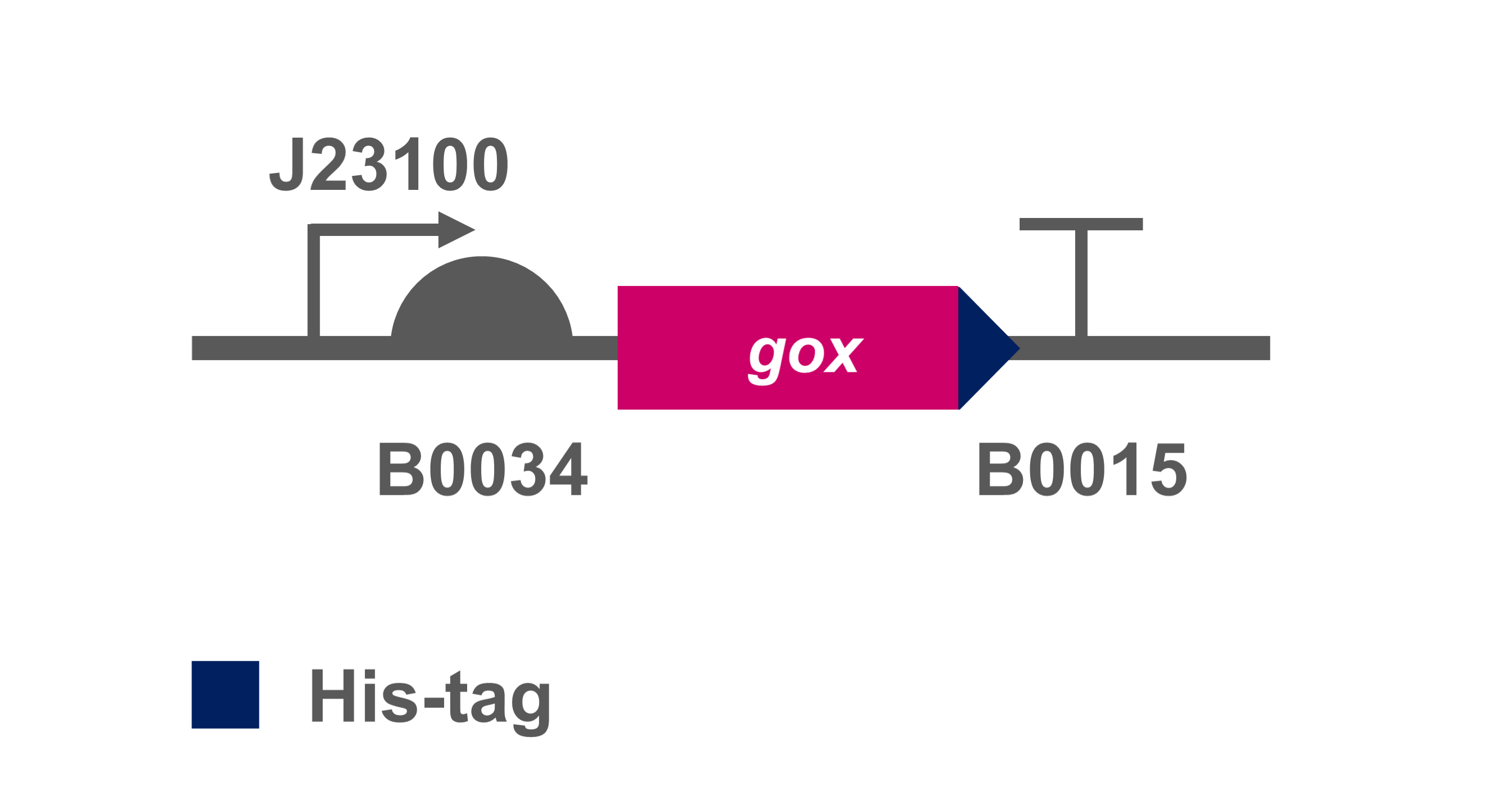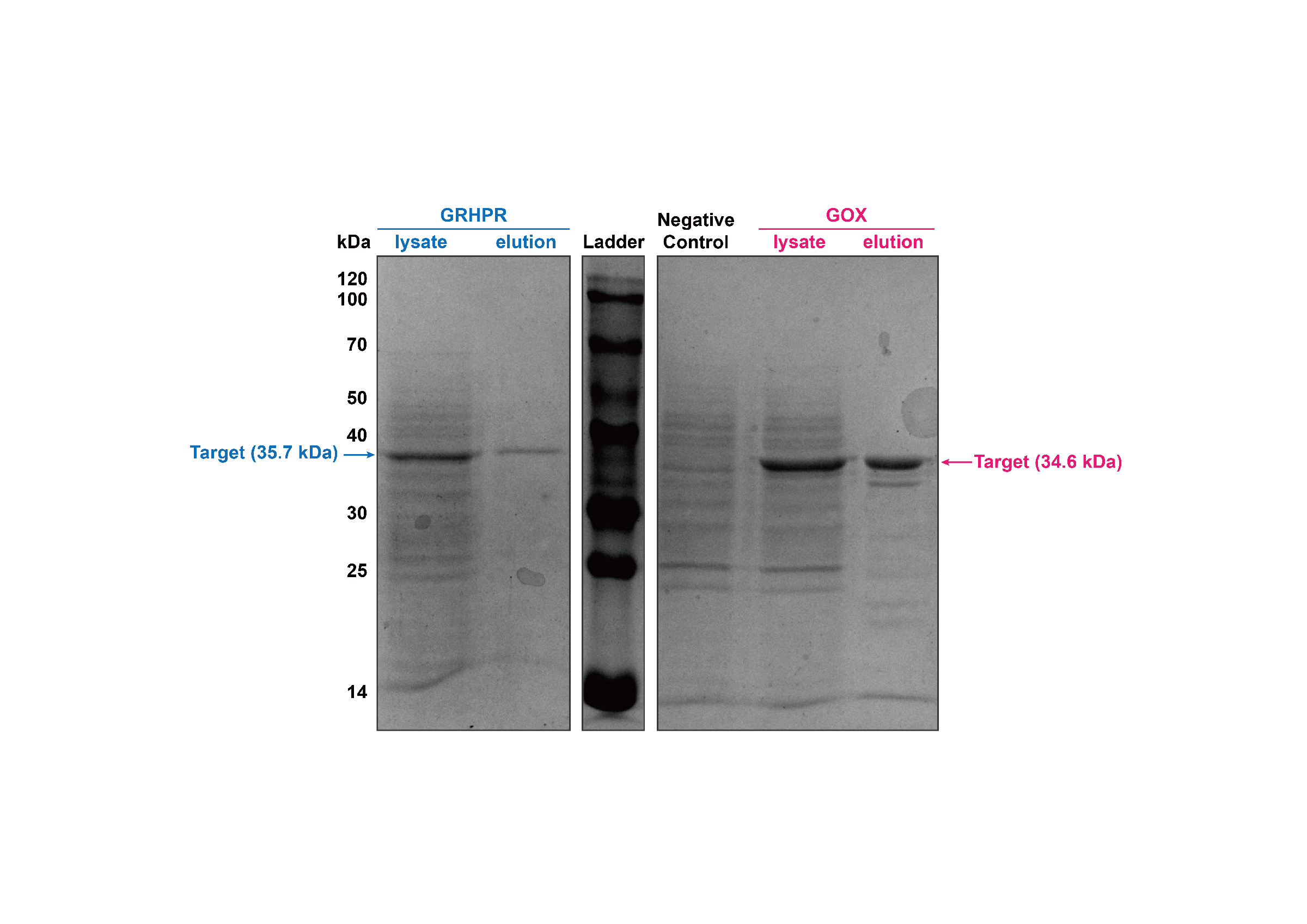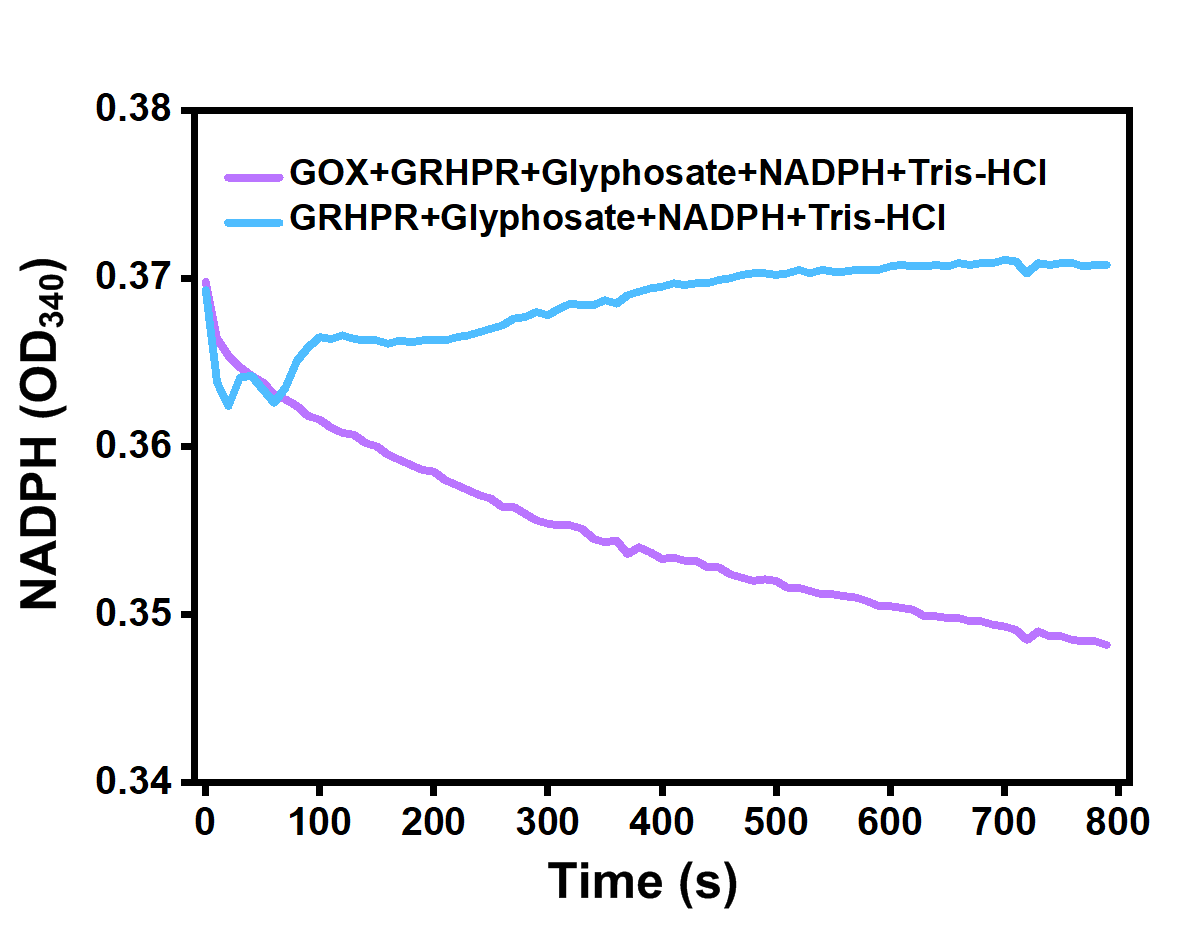Difference between revisions of "Part:BBa K3332006"
AnnaTaylor (Talk | contribs) |
|||
| Line 5: | Line 5: | ||
It can catalyze the reaction of degradating glyphosate to form glyoxalic acid and AMPA and add his-tag to purify the protein. We use K880005 to construct the expression system and to express and to purify the protein. | It can catalyze the reaction of degradating glyphosate to form glyoxalic acid and AMPA and add his-tag to purify the protein. We use K880005 to construct the expression system and to express and to purify the protein. | ||
| − | < | + | |
| − | === | + | ===Biology=== |
| + | |||
| + | As massive glyphosate has been over used all over the world, a world-wide evolution of glyphosate resistant (GR) weed species happens. An economically damaging grass weed called ''Echinochloa colona'' being an example. GOX, also known as EcAKR4-1, is found in ''Echinochloa colona''. It can decompose glyphosate into AMPA and glyoxylic acid. <ref>Pan L, Yu Q, Han H, et al. Aldo-keto Reductase Metabolizes Glyphosate and Confers Glyphosate Resistance in Echinochloa colona[J]. Plant Physiol, 2019, 181(4): 1519-1534.</ref> <ref>Rumsby G, Cregeen D P. Identification and expression of a cDNA for human hydroxypyruvate/glyoxylate reductase[J]. Biochimica et Biophysica Acta (BBA) - Gene Structure and Expression, 1999, 1446(3): 383-388.</ref> | ||
| + | |||
| + | <html> | ||
| + | <figure> | ||
| + | <img src="https://2020.igem.org/wiki/images/f/f1/T--XMU-China--XMU-China_2020-Mechanism_of_GOX_and_GRHPR.png" width="100%" style="float:center"> | ||
| + | <figcaption> | ||
| + | <p style="font-size:1rem"> | ||
| + | </p> | ||
| + | </figcaption> | ||
| + | </figure> | ||
| + | </html> | ||
| + | |||
| + | :'''Fig 1.''' Mechanism of GOX | ||
| + | |||
| + | |||
| + | ===Usage=== | ||
| + | |||
| + | By codon optimization and adding a 6His-tag, the sequence suitable for expression in ''E. coli'' was constructed. And we hoped that it could transform glyphosate into glyoxylic acid in ''E. coli'' to get fluorescence signal in the next processes we design. | ||
| + | |||
| + | The coding sequence of target gene was inserted into an expression vectors with <partinfo>BBa_K880005</partinfo>(<partinfo>BBa_J23100 </partinfo>& <partinfo>BBa_B0034</partinfo>) to obtain <partinfo>BBa_K3332051</partinfo>. We transformed the constructed plasmid into ''E. coli'' BL21 (DE3) to verify its successful heterologous expression. | ||
| + | |||
| + | <html> | ||
| + | <figure> | ||
| + | <img src="https://2020.igem.org/wiki/images/b/b6/T--XMU-China--XMU-China_2020-J23100_B0034_gox-his-tag_B0015.png" width="50%" style="float:center"> | ||
| + | <figcaption> | ||
| + | <p style="font-size:1rem"> | ||
| + | </p> | ||
| + | </figcaption> | ||
| + | </figure> | ||
| + | </html> | ||
| + | |||
| + | :'''Fig 2.''' Gene circuit of GOX | ||
| + | |||
| + | |||
| + | ===Characterization=== | ||
| + | |||
| + | '''1. Identification''' | ||
| + | |||
| + | After receiving the synthesized DNA, restriction digestion was done to certify that the plasmid was correct, and the experimental results were shown in figure3. | ||
| + | |||
| + | <html> | ||
| + | <figure> | ||
| + | <img src="https://2020.igem.org/wiki/images/e/e2/T--XMU-China--07172.png" width="90%" style="float:center"> | ||
| + | <figcaption> | ||
| + | <p style="font-size:1rem"> | ||
| + | </p> | ||
| + | </figcaption> | ||
| + | </figure> | ||
| + | </html> | ||
| + | |||
| + | :'''Fig 3.''' DNA gel electrophoresis of restriction digest products of GOX-Histag-pSB1C3 (''Xba''l I & ''Pst'' I sites) | ||
| + | |||
| + | '''2. Purification and Proof of the expression''' | ||
| + | |||
| + | We used J23100 promoter to highly express GOX-Histag in ''E. coli'' in our composite part <partinfo>BBa_K3332051</partinfo>. Then, we used GE AKTA Prime Plus FPLC System to get purified GOX protein. We found an apparent protein peak in AKTA FPLC System and correct purified protein. | ||
| + | |||
| + | Then, our target bands are observed through SDS-PAGE and the result is shown in figure4. | ||
| + | |||
| + | <html> | ||
| + | <figure> | ||
| + | <img src="https://2020.igem.org/wiki/images/b/b1/T--XMU-China--XMU-China_2020-GRHPR_and_GOX.png" width="90%" style="float:center"> | ||
| + | <figcaption> | ||
| + | <p style="font-size:1rem"> | ||
| + | </p> | ||
| + | </figcaption> | ||
| + | </figure> | ||
| + | </html> | ||
| + | |||
| + | :Fig 4. SDS-PAGE of purification products of GOX-Histag-pSB1C3 | ||
| + | |||
| + | '''3. Ability of degrading glyphosate''' | ||
| + | |||
| + | After transforming glyphosate into glyoxylic acid with the function of GOX, we use GRHPR, a Glyoxylate reductase from human liver, to reduce glyoxylic acid. GRHPR can convert glyoxylic acid when NADPH is consumed as cofactor. NADPH is a suitable target compound that can be detected by the signal of OD<sub>340</sub>. And when NADPH is consumed, OD<sub>340</sub> declines. | ||
| + | |||
| + | We mixed glyphosate solution, NADPH solution, GOX and GRHPR purified protein dissolved in Tris-HCl(pH=7.5). Then, we immediately detected OD<sub>340</sub> by using TECAN<sup>®</sup> Infinite M200 Pro to see the effect of GOX. | ||
| + | |||
| + | When using GOX & GRHPR, we successfully found OD<sub>340</sub> decrease as time went on. And in negative control sample (only using GRHPR), we cannot get any decrease. The results prove that GOX can convert glyphosate, which is shown in figure 5. | ||
| + | |||
| + | <html> | ||
| + | <figure> | ||
| + | <img src="https://2020.igem.org/wiki/images/c/cf/T--XMU-China--XMU-China_2020-GOX_OD340.png" width="60%" style="float:center"> | ||
| + | <figcaption> | ||
| + | <p style="font-size:1rem"> | ||
| + | </p> | ||
| + | </figcaption> | ||
| + | </figure> | ||
| + | </html> | ||
| + | |||
| + | :Fig 5. OD<sub>340</sub>-Time curve of GOX & GRHPR and negative control | ||
| + | |||
| + | |||
| + | ===References=== | ||
| + | <references/> | ||
| + | |||
| + | |||
<!-- --> | <!-- --> | ||
Revision as of 19:04, 26 October 2020
GOX-his-tag
It can catalyze the reaction of degradating glyphosate to form glyoxalic acid and AMPA and add his-tag to purify the protein. We use K880005 to construct the expression system and to express and to purify the protein.
Biology
As massive glyphosate has been over used all over the world, a world-wide evolution of glyphosate resistant (GR) weed species happens. An economically damaging grass weed called Echinochloa colona being an example. GOX, also known as EcAKR4-1, is found in Echinochloa colona. It can decompose glyphosate into AMPA and glyoxylic acid. [1] [2]

- Fig 1. Mechanism of GOX
Usage
By codon optimization and adding a 6His-tag, the sequence suitable for expression in E. coli was constructed. And we hoped that it could transform glyphosate into glyoxylic acid in E. coli to get fluorescence signal in the next processes we design.
The coding sequence of target gene was inserted into an expression vectors with BBa_K880005(BBa_J23100& BBa_B0034) to obtain BBa_K3332051. We transformed the constructed plasmid into E. coli BL21 (DE3) to verify its successful heterologous expression.

- Fig 2. Gene circuit of GOX
Characterization
1. Identification
After receiving the synthesized DNA, restriction digestion was done to certify that the plasmid was correct, and the experimental results were shown in figure3.

- Fig 3. DNA gel electrophoresis of restriction digest products of GOX-Histag-pSB1C3 (Xbal I & Pst I sites)
2. Purification and Proof of the expression
We used J23100 promoter to highly express GOX-Histag in E. coli in our composite part BBa_K3332051. Then, we used GE AKTA Prime Plus FPLC System to get purified GOX protein. We found an apparent protein peak in AKTA FPLC System and correct purified protein.
Then, our target bands are observed through SDS-PAGE and the result is shown in figure4.

- Fig 4. SDS-PAGE of purification products of GOX-Histag-pSB1C3
3. Ability of degrading glyphosate
After transforming glyphosate into glyoxylic acid with the function of GOX, we use GRHPR, a Glyoxylate reductase from human liver, to reduce glyoxylic acid. GRHPR can convert glyoxylic acid when NADPH is consumed as cofactor. NADPH is a suitable target compound that can be detected by the signal of OD340. And when NADPH is consumed, OD340 declines.
We mixed glyphosate solution, NADPH solution, GOX and GRHPR purified protein dissolved in Tris-HCl(pH=7.5). Then, we immediately detected OD340 by using TECAN® Infinite M200 Pro to see the effect of GOX.
When using GOX & GRHPR, we successfully found OD340 decrease as time went on. And in negative control sample (only using GRHPR), we cannot get any decrease. The results prove that GOX can convert glyphosate, which is shown in figure 5.

- Fig 5. OD340-Time curve of GOX & GRHPR and negative control
References
- ↑ Pan L, Yu Q, Han H, et al. Aldo-keto Reductase Metabolizes Glyphosate and Confers Glyphosate Resistance in Echinochloa colona[J]. Plant Physiol, 2019, 181(4): 1519-1534.
- ↑ Rumsby G, Cregeen D P. Identification and expression of a cDNA for human hydroxypyruvate/glyoxylate reductase[J]. Biochimica et Biophysica Acta (BBA) - Gene Structure and Expression, 1999, 1446(3): 383-388.
Sequence and Features
- 10COMPATIBLE WITH RFC[10]
- 12COMPATIBLE WITH RFC[12]
- 21INCOMPATIBLE WITH RFC[21]Illegal BglII site found at 294
- 23COMPATIBLE WITH RFC[23]
- 25INCOMPATIBLE WITH RFC[25]Illegal NgoMIV site found at 513
Illegal AgeI site found at 583
Illegal AgeI site found at 660 - 1000COMPATIBLE WITH RFC[1000]
